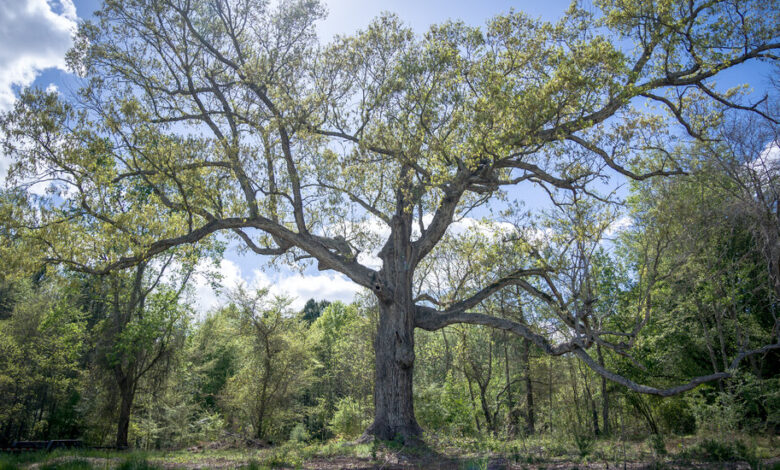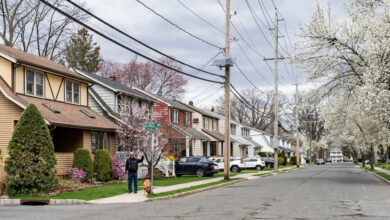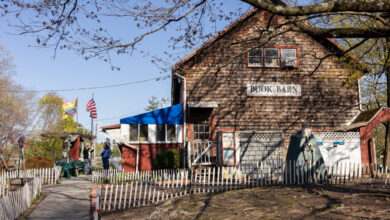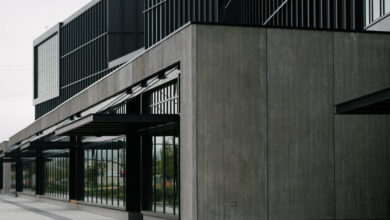Why This Eco-Friendly Gardener Doesn’t Cut Down Dead Trees

[ad_1]
It’s one of the costliest actions we take in managing our landscapes — in terms of dollars and environmental damage — and yet we keep cutting down and carting away the remains of trees. Even those that pose no danger to people or property.
Basil Camu, a founder of the Leaf & Limb tree-care company in Raleigh, N.C., wants us to rein in that obsessively tidy, controlling mind-set and let the safe ones stand. He believes so strongly in the role of trees — not just the healthy ones, but also snags, or wildlife trees, the dead and dying powerhouses of diversity that are often the first targeted for erasure — that he got out of the takedown business altogether.
Yes, he runs a tree service that doesn’t cut down trees, even dead ones.
His unconventional approach: Let it be.
“Let it participate and help the ecosystem,” Mr. Camu said. “When a tree dies, it enters into its second life, with this incredible new community that builds and thrives around it.”
Think of it as reincarnation (albeit in the same body).
The power of dead and dying trees is one of the most important messages in Mr. Camu’s new book, “From Wasteland to Wonder: Easy Ways We Can Help Heal Earth in the Sub/Urban Landscape.”
Learning to manage trees throughout their lifetimes, as they evolve into a final resting place as downed logs, gradually returning organic matter to the soil, is “an easy way to do less and spend less while also helping improve the health of the earth — which is essentially the thesis of the book,” he said.
Mr. Camu’s approach has won praise from Douglas Tallamy, a University of Delaware professor who is a leader in the movement to restore ecosystem function to our landscapes. “Basil’s logic will overwhelm any lingering doubts you may have had about this approach to landscaping, and provide that kick in the pants so many of us need to take action,” he wrote in an endorsement for the book, which Mr. Camu offers as a free digital download or for $10.75 in hardcover (his cost to print and ship it).
All of the lessons in “From Wasteland to Wonder” are aimed at promoting “outrageous diversity,” a phrase Mr. Camu borrowed from Michael Phillips, the holistic New Hampshire orchardist and author of “Mycorrhizal Planet,” who died in 2022.
“I just love that. I just had to use it,” Mr. Camu said. “I think dead trees are a perfect example of this. I mean, the number of birds and fungi and beetles and more — all of that support. It’s pretty wild.”
Pretty wild, indeed. Snags are a place for animals to roost or nest, thanks in no small part to the work of primary cavity nesters, notably woodpeckers, who excavate holes that also benefit others. Secondary cavity nesters include other birds — bluebirds, tree swallows, various wrens and owls, and even wood ducks — as well as flying squirrels, bats and more.
Snags offer a perch for hawks, eagles and owls hunting for prey, and for some male birds performing mating or territorial displays.
Eventually a snag will deteriorate into a downed log, providing cover for animals as small as salamanders or as large as bears. The fallen trunks also act as “nurse logs” that support the next generation of tree seedlings while the carcasses slowly degrade, becoming part of the soil from which they grew.
The decaying wood serves up a feast for insects and other arthropods who are themselves sustenance for many other animals, fuel for the food chain. Fungi make use of the wood, too, and then beetles feed on the fungi, and amphibians, reptiles and birds feed on those beetles.
You get the idea, Mr. Camu hopes: Outrageous diversity, all potentially in your backyard.
Reading the Tree Leaves (and the Bark and Roots)
The bulk of Mr. Camu’s work is about supporting living trees, emphasizing three key areas: soil health, structural pruning and annual inspections.
He encourages pruning, ideally from a young age, to promote “a dominant, straight trunk and well-spaced branches,” he said, that offer resilience against wind. Structural pruning can head off any number of problems, including multiple V-shaped branches that form angles of less than 45 degrees with the trunk, creating vulnerability.
Developing a trusted relationship with an arborist can help with that, and with reading our trees’ health — identifying which ones are moving toward senescence, for example, and require a safe, environmentally sensitive transition plan.
Most customer calls are triggered by fear, he said, with the presumption that a takedown is the answer. A tree has been seen swaying in a high wind (which is normal), or it appears to be leaning. Or maybe it seems dangerously large, or very old and of concern.
None of those things is a certain signal to remove the tree; further investigation is required. Responding to such calls, Mr. Camu begins his observations at the farthest edges of the tree’s canopy, looking for signs of decline.
This is very different from seeing decline on inner branches some distance down the tree. “It’s normal for interior lower branches to shade out,” he said. “And that distinction between inner and lower, versus outer and upper, is just so important, and the first big ‘aha’ for many people.”
Moving down the trunk, he checks to see if any big sheets of bark are falling off (assuming it’s not a species with exfoliating bark). Can he detect oozing, the scent of fermentation, black spots or anything abnormal growing on the surface of the trunk?
“Don’t count lichens and mosses,” he said. “Those are normal.”
Working his way to ground level, he said, he notes any mushrooms fruiting directly from the roots or trunk. Certain species of fungi signal concern.
More common, though, are buried root collars. The natural root flare at the tree’s base is all too often hidden under wood chips or other mulch piled too close to the trunk and too high (the dreaded volcano mulch), or beneath too much soil.
“If we cannot see a prominent flare at the base of the trunk,” Mr. Camu writes, “or if it looks like a telephone pole that disappears straight into the ground, we know the root collar is buried — it must be excavated and exposed ASAP.”
To roughly gauge the condition of the soil around the tree, a long screwdriver is his tool of choice. He calls it “an easy, fast proxy for soil health.” Generally, the deeper you can get the screwdriver in the ground with minimal effort, the healthier the soil is likely to be. He’d like to see it go in 10 to 12 inches.
If a tree is leaning in one direction, he inspects the ground on the opposite side. “If it feels light and spongy and there’s any roots popping up, that is almost surely a tree that’s falling over,” he said. “If the ground is very firm and stable, and it’s just as compacted on this side as it is on the other side, chances are it’s phototropism” — bending toward the light.
Can We at Least Leave a High Stump?
If Mr. Camu’s observations determine that a tree has begun its transition — or needs to, for safety — more evaluations follow. Will people be playing or walking nearby? Are there adjacent buildings or parking areas?
“Anything to do with people, how close that’s happening, and how frequently,” he said. “From there, we can make a plan.”
If there’s almost no surrounding activity? “Don’t do anything,” he said. “The tree will disintegrate naturally, and serve its maximum benefit.”
If, on the other hand, a tree has to be reduced in height or come down, one important note: Be sure to wait until after nesting season, unless there’s a hazard that requires immediate intervention.
And Mr. Camu suggests considering an alternative to the conventional approach of erasing every bit of the tree, including pulling or grinding down the stump. Instead, leave as much as possible intact — whether that’s a high stump or a wildlife tree 20 feet tall — because it will perform a critical ecosystem service.
Another possibility: Can most of the biomass be left on the ground to decay naturally where the tree once stood, and some branches be gathered into a brush pile? Those are wildlife-supporting landscape elements.
Just as he believes in the oldest trees, Mr. Camu champions the youngest. In 2017, he founded Project Pando, named for a colony of some 50,000 quaking aspens in Utah connected by a single root system. Now a nonprofit, the group propagates and distributes about 10,000 native saplings annually from wild-collected seed, mostly to other nonprofits and ecological restoration efforts. It also teaches organizations to set up similar propagation and distribution programs.
There is much work ahead in Mr. Camu’s tree-centric ecological mission, he knows. But how does he measure his moments of success along the way, as he promotes the importance of preserving trees people think need erasing, and planting more native ones?
“It’s when more people have taken these steps and have really fallen in love with the life that they have in their yard,” he said. “And they find beauty, they find meaning.”
That’s when they become part of “this movement,” he added, “toward living with other life.”
Margaret Roach is the creator of the website and podcast A Way to Garden, and a book of the same name.
If you have a gardening question, email it to Margaret Roach at [email protected], and she may address it in a future column.
[ad_2]
Source link






